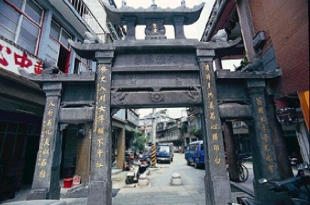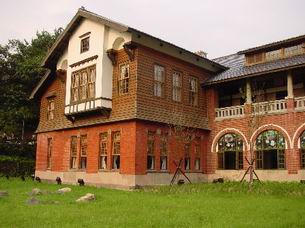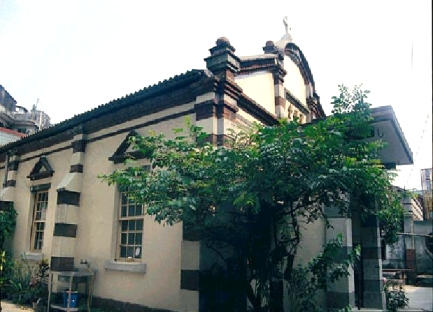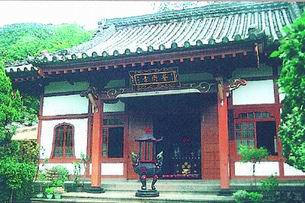 Zhou Family Widow's Memorial
Zhou Family Widow's Memorial
After the premature death of her husband, Lady Zhou Juan (1788-1846) became well regarded for preserving her chastity, raising her children like a devoted mother and remaining filial to her parents-in-law. In 1850, Governor General of Fujian and Zhejiang Liu Ke commissioned a gate to be built by the Ministry of Rites and Education in commemoration of Lady Zhou’s exemplary life. Originally the gate with four columns, three lateral sections and three levels of stone was completed in 1861. Parts of the first and second levels collapsed during an earthquake in 1897. A renovation by the Taipei City Government in 1992 has helped restore it as an important local landmark.
 Beitou Hot Spring Public Bath (Beitou Hot Springs Museum)
Beitou Hot Spring Public Bath (Beitou Hot Springs Museum)
The Beitou Hot Spring Public Bath dates from the early days of Japanese colonial rule. The Japanese traditionally believed hot springs to have healthful and therapeutic effects on habitues, but most bathhouses were too expensive for ordinary people to afford. The Taipei Prefectural Government construct of the Beitou Hot Spring Public Bath in 1911, and upon its completion in 1913, opened it to ordinary Japanese at reasonable rates.
The building was built of both bricks and wood. The first floor had walls of brick and concrete, with stained glass windows in the upper portion, while the second floor featured wooden clapboard siding. Vents were installed in the black tiled roof. The elegant building reminiscent of a British countryside villa, blends perfectly with its surroundings in Beitou Park.
Local community members succeeded in getting the bath declared a Class Three National Historical Site in 1997. Following renovations in 1998, the Taipei City Government reopened it as the Beitou Hot Springs Museum at which visitors are introduced to the building’s graceful architectural elements, general hot springs information, and the unique characteristics of hot spring baths in Taiwan.
 Beitou Presbyterian Church
Beitou Presbyterian Church
The Beitou Presbyterian Church, designed by Canadian missionary William Gauld in 1912, was established by Canadian missionary George Leslie Mackay. The structure is considered one of the oldest church buildings in Taipei. The congregation originally consisted largely of plains aborigines from the Beitou area. The building serves today as valuable historical evidence of Western religious development in Taiwan.
Built of red bricks and featuring a wooden frame in a style similar to British country churches, the church has exterior walls buttressed to protect it against earthquakes. It is the only surviving church designed by William Gauld in the 20th century.
 Puji Temple
Puji Temple
Puji Temple of Beitou is a rare example of a temple of the Shingon sect of Japanese Vajrayana Buddhism in Taiwan. Originally named Tiezhen Temple, it was built in 1905 from donations by Japanese railway employees. It is dedicated to the Goddess of Mercy Avalokiteshvara, who serves as a guardian spirit of hot springs.
Constructed in Japanese style, the temple has a well-preserved framework. The main hall has a single-eaved gable-and-hip roof. The layout is almost perfectly square, with both a width and a depth of three kaijian (a traditional unit of measurement equivalent to the standard width of a single room). The roof stretches forward, forming a cover for the front entrance – a popular design feature during the Edo Period in Japan. The entire temple is built of quality juniper. The wooden brackets and curved tie beams are decorated with elegant carvings. The bell-shaped windows are especially worthy of note. The main hall, the stone Avalokiteshvara image and the stele dedicated to Taiwan Railway Administration director Murakami Shoichi are all of great historical value.
 Old Taiwan Bank Dormitory
Old Taiwan Bank Dormitory
The Old Bank of Taiwan Dormitory in Beitou has three main buildings and a courtyard. The first building, situated closest to the road, was built around 1935, and originally served as the Shin Matsushita Hotel. The other two buildings, built around 1922 as the private villas of businessman Kozuka Kaneyoshi, were later purchased by Shin Matsushita and incorporated into the hotel grounds.
Around 1941, the Bank of Taiwan purchased the Shin Matsushita Hotel, using it as a club and lodge. Following World War II, it was converted into a dormitory for the employees of the Bank of Taiwan and their families.
The entire building is shaped similarly to a bridge and traverses a streambed, blending harmoniously with its natural surroundings, serving as a recreational venue of superlative quality. The building is highly valuable for its rare combination of Japanese exterior and Western decorative features.
The Beitou Granary
Built in 1938 during the Japanese colonial era, the granary was operated by the Beitou Credit and Purchasing![]() Cooperative. The Japanese colonial government set up a number of private farmers’ associations across Taiwan. Granaries and rice mills were also built to serve farmers; the buildings would vary slightly from place to place. Most farmers sold the rice they produced to farmers associations that owned dehulling machines.
Cooperative. The Japanese colonial government set up a number of private farmers’ associations across Taiwan. Granaries and rice mills were also built to serve farmers; the buildings would vary slightly from place to place. Most farmers sold the rice they produced to farmers associations that owned dehulling machines.
In 1920, the Agricultural Warehouse Law was passed and, thanks to enhanced water storage facilities, rice production in Taiwan soared. A granary was built here in 1938 because Beitou and Guandu Plain were the most productive rice-growing areas. After the war, a farmers’ association was established in Beitou in order to continue to serve local farmers. The implementation of the “fertilizer for grain” policy also increased production. Not only was the granary constantly busy managing supplies and sales, but it also offered loans.
Beitou Granary is laid out in an L-shaped plan consisting of offices, rice milling machines, and a long granary. The ventilation shaft protruding from the roof is commonly known as a “tai-zi-lou”. The interior is divided into a warehouse with a central conveyor belt and, to reduce heat, a brick-built arcade.
The brick-walled granary is divided into twelve areas. Bamboo nets were hung on the walls to protect the rice from moisture. The roof trusses were all made of wood. Unfortunately, some trusses collapsed due to vandalism while the application for national monument designation was ongoing. It is worth emphasizing that the granary’s well-preserved rice-milling machines are made of fine cypress and are a truly rare sight in Taiwan.
Taipei In-Service Teacher Training Center
Located at No. 2, Jianguo Street in Beitou District’s Yangmingshan, the municipal historic site Taipei In-Service Teachers Training Center was once a public bathhouse built in 1929.![]()
The large-scale Caoshan Public Bathhouse with octagonal baths for men and women was built in Caoshan, famous for its hot springs. When Caoshan was renamed Yangmingshan, the public bathhouse was abandoned. It was later used as administrative offices for Yangmingshan National Park and has now been converted into the Taipei In-Service Teacher Training Center.
The building was constructed in local materials. The walls are made of andesite, which is abundant in Caoshan, ranging in color from grey to violet. With its tiled pitched roof, the building exterior possesses a unique rural air.
The project was constructed by master craftsmen from Tamsui. The stone wall construction was inspired by Western architecture and is known as “Westerners stone”. This building was the first example of the technique seen in Taiwan and would later influence many others.
The bathhouse holds an important place in Taiwanese hot spring culture history, as well as for the materials and techniques used in its construction.
Beitou Grotto to the Buddhist Deity Acala
Located across from No. 2, Xinglin Lane, Youya Road in Beitou District, the municipal historic site Beitou Grotto to the Buddhist Deity Acala is one of the few Buddhist grottoes in Taiwan.![]()
The five primary Buddhist deities are Acala, Trailokyavijaya, Kuṇḍali Vidyārāja, Yamāntaka, and Vajrayaksa, also known as the Five Great Wisdom Kings. There are also Eight Great Bodhisattvas, or Ten Great Wisdom Kings, who are all guardian gods, hence their mean demeanor.
It has also been said that Acala is an incarnation of Mahavairocana Tathāgata of the Vajrayāna Shingon Buddhism, which is rare in Taiwan. The noose held in Acala’s left hand is said to be used to bind ghosts, while the sword in his right hand can subdue demons.
The Beitou Grotto for the Buddhist Deity Acala is a rock-cut cave that houses stone-carved gods. It was built in 1925 by Sano Shotaro to bring success to his hot-spring hotel business.
The grotto is small and has a chōzuya (water purification station) and a pavilion in front and a spring waterfall next to the cave. With its unique and beautiful setting, the Beitou Grotto to the Buddhist Deity Acala is considered one of the most scenic spots in Beitou.

![Taiwan.gov.tw [ open a new window]](/images/egov.png)
